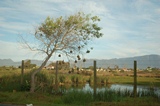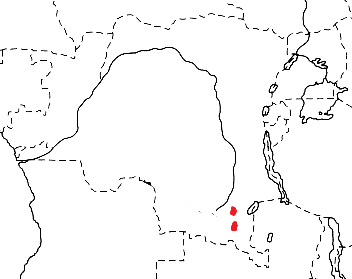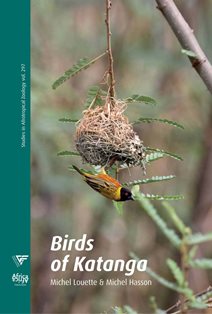Weaver species
Choose different species from drop-down list and press 'Go' button. See Full species list.Lufira Masked Weaver Ploceus ruweti
IUCN: Data Deficient Discovery: 116Categories: wetland, IUCN,
News items about species
Discovery
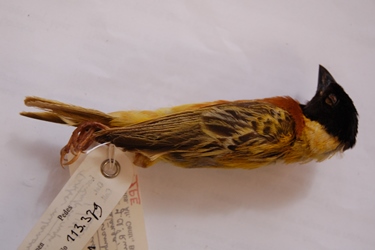
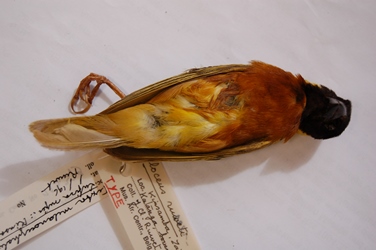
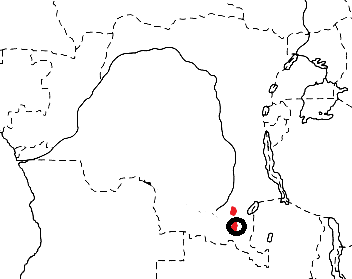
distribution, type locality circled IntroductionThe Lufira Masked Weaver was formally described by Michel Louette, a Belgian ornithologist and author, and by Con W Benson, a British ornithologist. The Lufira Masked Weaver was first collected by Jean-Claude Ruwet, a Belgian zoologist and collector.Ruwet studied the avifauna of Katanga, DRC, and wrote several papers. Ruwet studied the breeding habits of a weaver that he thought was P. melocephalus in the swamps bordering Lake Lufira (now called Lake Shangalele, or Tshangalele). Ruwet recorded several colonies, including one of more than 20 nests. Ruwet collected one specimen at Kinsamba, near the eastern edge of the maximum level of the lake. This specimen was a male in almost complete breeding plumage, collected in 1960, probably in the month of March. Verheyen attributed the specimen to the subspecies dimidiatus, while Schouteden 1971a omitted this record from his summary of P. melocephalus specimens. Louette and Benson examined Ruwet's specimen and compared it to other similar species, and realised that it was a new species. These authors note that the Lufira Masked Weaver differs markedly from other similar weavers in bill shape, and they suspected that its nearest relative is P. reichardi. The Lufira Masked Weaver was first illustrated in the type description, by black and white photos of the type specimen, of a nest, and of a breeding colony. Scientific citationPloceus ruweti Louette 1982a, Bull. Br. Orn. Club 102 p.26, Kinsamba, Lake Lufira, Zaire.Meaning of namesruweti, Named after J.C. Ruwet (fl. 1965), a Belgian ornithologist.First English nameLufira Masked Weaver (Howard 1984a).Alternate namesLake Lufira Weaver, Ruwet's Masked-Weaver.CollectorJC Ruwet.Date collected1960, probably March.Locality collectedKinsamba, Lufira area, DRC.Type specimensThe type is in the Tervuren Museum (MRAC_A.113379). |
The above is based on Weaver Wednesday 2, a weekly series about the discovery of each weaver species.
This species text first appeared as
Weaver Wednesday [233] - Discovery [116]: Lufira Masked Weaver on 2016-11-30
1. Basic biology
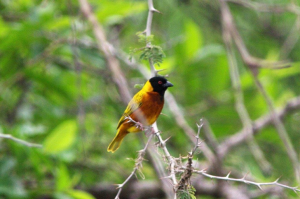
figure from BirdPix 6938 Identification. The Lufira Masked Weaver Ploceus ruweti breeding male has a black head and a strong chestnut wash on the breast and flanks, which distinguishes it from the Lesser Masked Weaver, Southern Masked Weaver, and Katanga Masked Weaver. It is also similar to the Tanganyika Masked Weaver but the black on the head of the Lufira Masked Weaver extends as far as the hind-crown. The female Lufira Masked Weaver is greenish above, dull yellow below and shows two wingbars. Distribution.
The Lufira Masked Weaver is found at Lake Tshangalele (formerly Lake Lufira) and Kiubo Falls, c. 120 km downstream on the Lufira River, in DRCongo (see map below, based on Birds of Africa and recent information).
Habitat. The Lufira Masked Weaver inhabits riverside vegetation, but nests in ambatch and acacia trees, rather than in the reeds. Food.
The diet of the Lufira Masked Weaver is seeds and insects, and the young are fed on insects.
Breeding.
The Lufira Masked Weaver is probably polygynous. Males are territorial and usually have 4-6 nests, but may have 3-20 nests in some sites. The nest is oval, with the entrance below and little or no spout. The nest is woven by the male from strips of material, and suspended from branches above the water. Two colonies were close to nests of the wasp Ropalidia cincta.
One clutch had 2 eggs, very pale green with brown spots, and spots concentrated at the thick end. Nothing else is known about its breeding habits. |
The above is based on Weaver Wednesday, a weekly series about weaver species.
This species text first appeared as
Weaver Wednesday [115]: Lufira Masked Weaver on 2014-08-27
2. Breeding facts
| Pair bond Probably polygynous Breeding season Jan-Apr Nest site suspended from a woven strip attached to ambatch branches 0.5-2 m above water Nest building woven by male Colony size neighbouring males each with several nests, but apparently not colonial; 3-20 nests in some sites, typically 4-6 nests together Clutch size 2 eggs in one nest Egg colour very pale green with brown spots, spots concentrated at thick end Egg size one egg 19.4 x 13.9 mm Incubation no information Chicks and nestling period male seen to feed a fledgling |
Breeding information based on Handbook of the Birds of the World, Vol. 15.
3. Photos of Weaver Nests
 Vm 15816 | 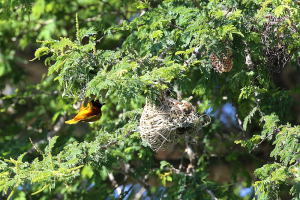 Vm 15815 |
Thumb-nails of most recent PHOWN records - click on one to see its full record
See all PHOWN records for this species here.
PHOWN (Photos of Weaver Nests) provides valuable info on breeding distribution and colony sizes of weavers.
You can contribute by registering and submitting photos at Virtual Museum webpage.
4. Breeding distribution
Google map showing distribution (For species with small ranges you need to zoom in at the correct area to see the range):
yellow blob - range of weaver species; read more about this here.
![]() - PHOWN records with photos
- PHOWN records with photos
![]() - PHOWN records with no photos (Nest Record Cards, other records)
- PHOWN records with no photos (Nest Record Cards, other records)
![]() - Birdpix records
- Birdpix records
![]() - comments on out of range records, or interesting records
- comments on out of range records, or interesting records
![]() - type locality
- type locality
CLICK on the marker on the map to see individual record details.
5. Range changes
Not South African speciesThe above is based on Weaver Wednesday 3, a weekly series about range changes in South African weaver species.
This species text first appeared as
n/a








